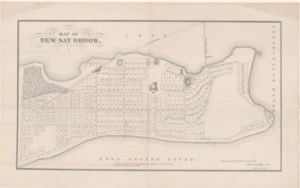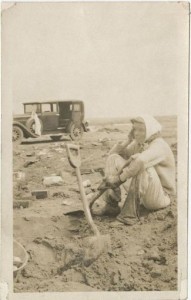By Anne Guernsey for Your Public Media
John Warner Barber’s 1834 drawing of Saybrook Point shows the area that would later be known as Fenwick, located where the Connecticut River flows into Long Island Sound. A light house, which was rebuilt in 1839, is visible in the distance. Fenwick today has two lighthouses—the Inner (situated at the tip of Lynde Point on Fenwick’s peninsula) and the Outer (standing tall on a rough jetty about a quarter mile off shore). The Outer Lighthouse is so iconic that it is featured on Connecticut “Preserve the Sound” License plates.

John Warner Barber, Saybrook Point, 1834, drawing – Connecticut Historical Society and Connecticut History Online
The completion of the Connecticut Valley Railroad in May 1871 inspired a group of wealthy and prominent Hartford citizens to form the New Say Brook Company to develop the area as a summer resort for gentlemen and their families. Early residents included Leverett Brainard, Newton C. Brainard, Morgan G. Bulkeley, and the Reverend Francis Goodwin. An early map shows the real estate development before most of the lots were sold and the summer homes were erected. Many families purchased multiple lots to provide space for their roomy cottages.

Map of New Say Brook, Surveyed by William R. Clarke, Printed by the Kellogg & Bulkeley Co., after 1871 – Connecticut Historical Society
Upper-class life at Fenwick’s summer colony is documented in numerous photographs in The Connecticut Historical Society’s collection. Stately Victorian and Stick-style cottages line Beach Road in a photograph taken about 1885. (The term Stick-style refers to the use of wood ornamentation set in grids and at angles on the building’s exterior to suggest its internal structural framing.) The cottages had names like Reversea and Agawam and they had sweeping porches, perfect for relaxation on summer afternoons.

Actress Katharine Hepburn seated on the beach, Fenwick, 1938 – Connecticut Historical Society
Perhaps Fenwick’s most famous resident was Katharine Houghton Hepburn. In her bestselling autobiography, Me, Hepburn wrote: “Fenwick is and always has been my other paradise.” Hepburn spent summers there with her family and, while her successful Hollywood career kept her away for long stretches of time, she always returned to Fenwick. A series of photographs at The Connecticut Historical Society shows her on the beach amidst the debris which was all that was left of her home following the Hurricane of 1938. The Hepburn house was later rebuilt and Hepburn died there in 2003 at the age of 96.
Anne Guernsey, who holds a Master’s degree in Art History, was formerly the Manager of Institutional Advancement at the Connecticut Historical Society.
© Connecticut Public Broadcasting Network and Connecticut Historical Society. All rights reserved. This article originally appeared on Your Public Media.
Note: ConnecticutHistory.org does not edit content originally published on another platform and therefore does not update any instances of outdated content or language.









